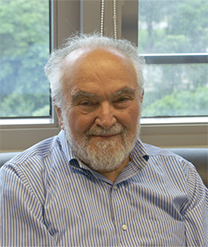| 發刊日期 |
2012年9月
|
|---|---|
| 標題 | 有朋自遠方來一專訪Joel Lebowitz教授 |
| 關鍵字 | |
| 檔案下載 | |
| 全文 |
策 劃 : 劉太平 
Joel Lebowitz, 1930年出生於捷克斯拉夫Taceva城(現屬烏克蘭)。
1953年布魯克林學院(Brooklyn College)學士, 1956年雪城大學(Syracuse University)博士。
歷任史蒂文斯科技學院(Steven Institute of Technology) (1957-1959), 葉史瓦大學(Yeshiva University) (1959-1965)教授,
現任職羅格斯大學(Rutgers University)。先生於統計力學有寬廣的貢獻, 創辦Journal of Statistical Physics, 多年積極舉辦活動, 桃李遍佈。
先生為美國國家科學院院士, 得多項數學和物理界榮譽。
劉太平 (以下簡稱「劉」): 先問您一個傳統的問題, 您怎麼決定要走統計力學與理論物理這個方向的? Joel Lebowitz (以下簡稱「L」): 我在布魯克林學院(Brooklyn College)念大學的時候, Melba Phillips1 1 Melba Newell Phillips (1907-2004), 美國物理學家與科學教育家, 以1935年的歐本海默-菲利普斯效應(Oppenheimer-Phillips effect)而為人所知。 是我的老師, 她曾經與人合寫過一本很有名的書, "Classical Electricity and Magnetism2 2 Wolfgang K. H. Panofsky and Melba Phillips, Classical Electricity and Magnetism, 1962, Addison-Wesley Pub. Co.", 你應該聽過這本書。 她是 J. Robert Oppenheimer3 3 J. Robert Oppenheimer (1904-1967), 美國理論物理學家, 因為他在第二次世界大戰主持曼哈頓計畫 (Manhattan Project)被稱為「原子彈之父(father of the atomic bomb)」。 的學生和博士後。 我決定要念研究所的時候, 她推薦我去雪城大學(Syracuse University)跟他的朋友Peter Bergmann4 4 Peter Gabriel Bergmann (1915-2002), 德裔美籍物理學家, 以他與愛因斯坦的統一場論(unified field theory)的工作最廣為人知。 。 Peter 主要研究廣義相對論, 他曾是 Einstein5 5 Albert Einstein (1879-1955), 猶太裔理論物理學家, 相對論的創立者, 被譽為「現代物理學之父」。 的博士後, 在跟愛因斯坦一起做的時候, 也對統計力學有興趣。 Melba Phillips 用 Peter Bergmann 寫的統計力學的書在學院教過大四程度的課。 我想那應該是我選擇統計力學的緣故。 記得在大學畢業升研究所的那個暑假, 看了一本統計力學的書。 我在雪城時, Peter也正對統計力學感興趣。我修的幾門課中, 有一門是鍾開萊開6 6 Kai-Lai Chung 鍾開萊(1917-2009), 華裔美籍數學家, 著有多本機率方面的專書, 廣被採用。 的機率論, 那段時間他剛好在雪城大學教書。 那是我修的第一門機率論的課, 其實我是物理系的學生, 我不記得當時是旁聽還是正式註冊那門課。 在雪城大學的第一年有兩件事情值得一提, 第一件是到匹茲堡(Pittsburgh)參加統計力學的會議, 那時候我是第一年的研究生, Peter Bergmann的眾多學生之一, 我們大家開車到匹茲堡參加這個會議。 Onsager7 7 Lars Onsager (1903-1976), 挪威裔美籍物理化學與理論物理學家, 1968年諾貝爾化學獎得主。也參加了這個會議。第二件是機率學家 Doob8 8 Joseph Leo Doob (1910-2004), 美國數學家, 擅長分析與機率理論, 創立鞅論( theory of martingales)。來雪城大學演講, 因此我開始看他的書。 Mark Kac9 9 Mark Kac (1914-1984), 波蘭數學家, 在機率, 數學, 物理等領域有深的貢獻, 他的問題 "你可以聽到鼓的形狀嗎(Can one hear the shape of a drum?)"帶動譜理論( spectral theory)的研究。在我研究生第一年與第二年的時候訪問雪城大學, 那時候他在康乃爾大學任教。 他講了有關Onsager對Ising Model的解。我還記得開始的時候, 剛巧是李政道10 10 Tsung-Dao Lee 李政道 (1926- ), 華裔美籍數學家, 在30歲的時候與楊振寧一起得到1957年諾貝爾物理獎。與楊振寧11 11 Chen-Ning Franklin Yang 楊振寧 (1922- ), 華裔美籍物理學家, 與李政道一起得到1957年諾貝爾物理獎。發表關於Ising Model的分割函數零點 (zeros of the partition function) 的理論, 為了這個我們開了一個給研究生的專題討論班 (seminar)。 那段期間在統計力學方向上有許多的發展。 劉: 喔, 都是重要的科學家。 L: 那時候真是那樣, 因為你的問題才讓我想起這些塵封許久的往事。 劉: 你記得Onsager, Doob, Mark Kac是甚麼樣的人或科學家? 還有任何印象嗎? L: 我跟Onsager很熟, 他帶過我一年的博士後研究。1956年研究所畢業後, 一直到1957年我是他的博士後。 他不僅是傑出的科學家也是很有意思的人。他對自己調配的馬丁尼(martini)很自豪, 那段時期, 我喝過不少好喝的馬丁尼。 他對園藝可以說是無所不知, 其它事情也懂得很多。同時他總是有辦法從行政職務脫身。我當博士後的時候住在紐約, Onsager在新港(New Haven)的耶魯大學(Yale University), 所以我每周開車去一趟新港與他討論一整天。他很神, 不用查書就可以做Bessel函數三次方的積分, 當他收到一些新的論文的時候, 會到檔案櫃裡拿出舊的筆記查對文章內容是否有誤。 他真的既高妙又有意思, 喜歡講一些預言玄妙之事。 我特別記得有一次我跟Oliver Penrose12 12 Oliver Penrose (1929- ), 英國理論物理學家, 以非對角長程序概念(concept of off-diagonal long-range order)最廣為人知。一起參加一個會議, 那時我跟他做博士後研究, 我們一起做一個亞穩定性(meta stability)的問題, Onsager在旅館的大廳問我們 "你們覺得什麼是亞穩定性, 一種平衡現象(equilibrium phenomenon)?或是動能現象(kinetic phenomenon)而非平衡現象?" 我想了一會兒, 他的答案是:「在加拿大有間工廠生產一種膠質, 工廠的運作很穩定, 但是有一個冬天水管受凍結冰, 工廠只好遷移。」 聽完這個故事應該要想到亞穩定性是一種動能現象, 但是我花了不少時間才想通這個道理, 因為水管一旦結凍過, 就留下一些因子, 水管已經變質了, 之後每年冬天都會結冰。這就是Onsager說話的方式。又有一次我跟 Elliott Lieb13 13 Elliott H. Lieb (1932-), 美國數學物理學家, 主要研究統計力學與凝態理論和泛函分析。研究 Coulomb's system 需要 chi's theorem --- 用不同直徑的球填滿一個箱子, 球越縮越小, 可以填到無限接近滿。 我把這個說給 Onsager 聽, 他說:"啊, 這是我在工學院學的, 最好的水泥是用分級的砂礫組成的。" 所謂分級的砂礫是指各種大小的砂礫, 用這樣做成的水泥, 施工的時候可以填得最平整, 所以是最好的水泥。 我不認識 Doob, 只遇過他一、二次。我後來和 Mark Kac 也很熟。我們一起擔任過一個人權組織 --- 關注科學家協會 (Committee of Concerned Scientists)的共同主席, 是在那時候我才跟他熟稔, 在他跟 Uhlenbeck14 14 George Uhlenbeck (1900-1988), 德裔美籍理論物理學家, 1979年獲頒物理沃爾夫獎。與 Hemmer15 15 Per Christian Hemmer (1933- ), 挪威物理學家。一起做研究時我們也有接觸, 都是些很棒的人。 劉: 現在與過去的環境有很大的不同, 年輕人有更多會議要參加, 也會遇到更多的人。你對他們有甚麼建議? L: 我不覺得有很大的差別。至少我每年都會舉辦兩次統計力學會議, 很多輩分很高的人像 Freeman Dyson16 16 Freeman John Dyson FRS (1923- ), 英裔美籍理論物理學與數學家, 以他在量子電動力學、固態物理、天文學等多領域有深入的研究。, Phil Anderson17 17 Philip Warren Anderson (1923- ), 美國物理學家, 1977年諾貝爾物理獎得主。和 Michael Fisher18 18 Michael Ellis Fisher (1931- ), 英國物理、 化學與數學家, 以他對統計物理的貢獻而聞名。與其他人都會與會, 年輕人還是有機會可以接觸到他們。 我想重點是不能害羞, 你也知道, 像Varadhan就很歡迎年輕人或是任何人去找他。 我已經不年輕了, 所以回答這個問題可能不是很合適, 但我覺得差異性沒有那麼大, 重點是不能太害羞。 劉: 這對年輕人是很大的鼓勵。2003年我們在羅馬的義大利科學研究學院(Accademia dei Lincei) 參加同一個會議, 有次過街的時候, 兩邊車流不斷, 我不知道該怎麼過馬路, 你卻胸有成竹緩慢的穿過馬路。 我記得很清楚, 過了馬路之後我問你「是不是因為你年輕時經歷過坎坷的境遇, 因而在面對困難時能夠有這樣的從容。」我這樣說還合理嗎? L: 合理, 絕對有憑據的。 劉: 在科學研究方面有很多事情由你起頭, 例如你剛剛提到的一年兩次的統計力學會議, 創辦了重要的期刊 "Journal of Statistical Physics19 19 Journal of Statistical Physics, ISSN: 0022-4715, Springer出版。", 同時也是關注科學家協會的主席, 你做這些事情的動力是什麼? L: 不同的事情有不同的動力。 會議是因為我很享受它們, 但我想中國有一句諺語「千里之行始於足下」, 所以只要每次踏出一步, 持續前進就好, 起碼會議就是這樣持續下來。 1961年我在史蒂文斯科技學院(Steven's Institute of Technology)舉辦第一次會議, 今年(2011)12月是第106次舉行。 劉: 這些會議讓你們成了一個緊密的家族。 L: 常常相聚至少有幫助。它讓統計力學成為一個友善的科目, 與科學界其它領域相比競爭相對不那麼激烈。 舉辦這些會議我樂在其中。至於關注科學家協會, 如同你提到的, 我本身就遭遇過人權迫害。 我想人權對每個人都是重要的, 尤其是科學家。我認為科學家有一種特別的 洞察力, 宏觀宇宙及事物的真相。 當人類試著去瞭解宇宙時, 將會發現人類共有的特質與相 似處遠比分化人類為不同種類的差異性來的更多, 所以科學家應該更意識到支持美好的事 情,以及支持人權與自由的重要。 不管如何, 某方面來說, 我們應該體認到或知道哪些是重 要的, 哪些不是, 希望每個人都可以有些微正面的貢獻。 劉: 所以科學家應該作為人類的表率。 L: 我認為是的。特別是我們這些有幸住在自由國家又有好的經濟條件的人更應該對弱勢者有同理心與同情心。 劉: 有理, 也許我這樣說不很正確, 不過這樣的想法應該像信仰一樣深植人心, 是我們的責任與義務。 你的研究方向很廣, 透過合作或師或友與許多人直接接觸過。我可以問你一個非常狹隘的問題, 在你自己的研究生涯中有那些印象深刻, 愉快的時刻? L: 有, 是在幾次不同的場合。我印象特別深的是, 有一次坐太太的車一起到鄉下去, 一路上我思考著如何證明Coulomb系統 (Coulomb system)和長程勢(long range potentials)的動力極限存在的問題, 這也是Elliott Lieb和我後來一起合作的問題。 後來, 淋浴的時候我忽然想通了Kac勢的長程漸近(long range Kac potentials about asymptotic)的一些關鍵。 劉: 你那時候幾歲? L: 那時候大概是60年代中, 所以是35歲。這是做科學、研究數學的快樂之一, 靈光乍現的神奇時刻是哪裡都走不通、一無所成、許許多多寂寞日子之後的回饋。 劉: 那些短暫的時刻帶來長時間的安慰。你跟Elliott Lieb合作, 他跟你很不同。 L: 是不一樣, 但我們相處愉快。我們從在葉史瓦大學(Yeshiva University)短暫共事, 已經是老朋友了。我們第一篇合作的文章是關於諧波晶體熱傳導 (heat conduction in harmonic crystals), 那也是60年代的事。他在普林斯頓大學任教, 我在羅格斯, 不過都住在普林斯敦。我們不時一起合作有很長的時間了。 值得一提的是我們已經有個傳統, 每年四次, 在我倆及太太們生日時共進晚餐慶生。我跟一些非常出色的人合作過, Eric Carlen20 20 Eric A Carlen, 數學家, 現任教羅格斯大學(Rutgers University), 研究領域包含泛函分析與機率。就是我的同事。 劉: 他前幾年到羅格斯去的。 L: 是的, 之後我們就一起合作。我也跟Clément Mouhot21 21 Clément Mouhot (1978- ), 年輕法國數學家, 研究偏微分方程。合作一些動力理論的研究。 劉: 喔, 我沒聽說過。 L: 我們才剛開始, 只通了幾封信。 劉: 他年輕又聰明, 你這兩位年輕的合作者我都熟識。優秀的年輕人一直出現是很好的事情。 L: 真的很棒, 他們的年紀似乎越來越小。 劉: 我喜歡你的觀點, 你到現在還是充滿活力, 從你的第一篇論文到現在已經做了幾年的研究了? L: 我在1954年發表第一篇論文, 到現在已經有57個年頭。做得比我久的大有人在。 Phil Anderson已經88歲了, Dyson也是88歲, 他們都還沒停下來。Joe Keller22 22 Joseph B. Keller (1923- ), 美國數學家, 研究應用數學, 以在幾何繞射理論(Geometrical Theory of Diffraction)的工作而聞名。也87歲了, 所以還是有些人讓我看齊。 劉: 所以算起來你還算是年輕一輩。你最近有什麼喜好? L: 還在做非平衡統計力學 (non-equilibrium statistical mechanics)。 劉: 你怎麼定義非平衡統計力學?那是什麼? L: 簡單的說就是微觀下的動力學(kinetic theory but on a more microscopic level)。 就是日常發生的隨時間演化的系統, 但是是非平衡的凝止態, 這是從動力學來的問題, 實際上不是來自波茲曼方程(Boltzmann equation)或Navier-Stokes方程(Navier-Stokes equation), 比較是由微觀動力學而來。 我對從量子力學觀點看這些現象也有興趣。但一般來說, 我想非平衡就像非線性一樣, 除了極小的部分是平衡之外, 其它都是非平衡。 劉: 平衡是特例。 L: 的確, 就像線性是特例一樣。 劉: 不過大部分的變化都是因為這些特例引起的。 L: 就像在燈光下找鑰匙的故事一樣。 劉: 我有一個一般性的問題要問, 這個問題是因為我問的另一個問題:波茲曼 (Boltzmann23 23 Ludwig Eduard Boltzmann (1844-1906), 奧地利物理學家, 科學界尊為"統計力學之父"。) 如何發現H-theorem, 為什麼是對數函數(logarithmic function)? 這個問題我問過很多人也聽過各式樣的回答, Peter Lax24 24 Peter David Lax (1926- ), 美國數學家, 詳第26卷第4期「有朋自遠方來」專訪。說 information theory entropy, 但那是波茲曼後來才做的。 我不止一次提過 Joel Lebowitz 有最好的答案, 波茲曼應該試過好幾種函數。 L: 在他的文章中, Boltzmann發現如果把熵(entropy)等同於相(phase)空間的對數(log)值 (這 $S = k \log W$ 就刻在他的墓碑上)。 在一個系統裡, 如果勢能 (potential energy) 可以忽略的話, 看單粒子的分佈, 去算相應的六維的相空間的體積, 就得到 $f\! \log f$和 -$f\! \log f$; 如果在一個給定的能量層上看, 你會得相空間體積的對數。兩個看法等同;一個得到相空間的對數, 另一得 $f \log f$。 所以你應該把 $f$ 想成實驗得的分佈, 而去問, 對應不同 $f$ 的相空間體積為何。你會發現它就是 $f \log f$。 如果你要極大化, 那就取 $f \log f$; 要極小化就取 -$f \!\log f$。 我喜歡如此去思考 $f \log f$。 劉: 當然這些統計力學上的想法是在他得到 H-Theorem 之後所發展出來的。 L: 關於利用對數函數而得到 H-Theorem, 我肯定他有過許多嘗試。我猜他發現可以這麼做的時候, 應該也有那個特別的, 靈光乍現的神奇時刻。 劉: 現在數學當然是科學的必備, 不過數學系的活動只在數學系內部;在教學上, 基本科目依然有微積分、 線性代數等, 這些都是文明人應該知道的科目。但是如果我們說數學對科學發展已經不如19世紀那時候一樣重要, 這樣說對嗎? L: 你知道數學裡有些非常抽象的分支, 但出乎意料的, 很多時候就連最抽象的數學都有其應用。 劉: 就像數論。 L: 是的, 我想現在很多數學家, 確實不像19世紀時的數學家直接針對自然科學的問題做研究。 很久以前Freedman Dyson寫過一篇很有意思的文章, 其中提到數學家沒有將主要的時間精力用在馬克斯威爾方程 (Maxwell equations)的研究上, 他認為數學家進入那個領域的時間應該要更早。但我認為數學有它自己獨特的內部動力, 不過他說的也是對的。 Wigner25 25 Eugene Paul E. P. Wigner (1902-1995), 匈牙利籍美裔理論物理學與數學家, 於1963年獲頒諾貝爾物理獎。 有一句名言 :「數學在自然科學中的驚人用處是神祕而且沒法用理性解釋的26 26 原文「The enormous usefulness of mathematics in the natural sciences is something bordering on the mysterious and that there is no rational explanation for it」。」 確實數學一直有意想不到的用處。 劉: 應該讓好奇心引領我們。 L: 沒錯。最近我又重讀了一篇Wigner寫的非常出色的文章27 27 "The Unreasonable Effectiveness of Mathematics in the Natural Sciences" https://www.dartmouth.edu/~matc/MathDrama/reading/Wigner.html。 你知道這篇文章嗎? 文章的開頭是一個故事, 有兩位大學室友, 畢業後一位從商, 另一位是統計學家。 偶然相遇, 一個問:「你在做什麼?」一個說:「我在做一些身高分佈的統計。」另一個人看到他的圖表跟公式裡面有 $\pi$, 問:「$\pi$是什麼?」「圓周率。」「你在開玩笑吧!圓周率跟身高分佈怎麼會有任何關係。你在戲弄我吧。」所以雖然很意外, 但就是有關係。 劉: 你不做研究的時候都做些什麼?有什麼喜好? L: 好問題!如果有很多時間, 我喜歡游泳, 我有個游泳池, 也喜歡看電影, 但不大有時間去。年輕的時候會做一些陶藝, 但那是很久以前, 也許有一天會再回頭。 劉: 陶藝, 那需要很多技巧, 對嗎?有雕塑, 也有化學的部分。 L: 我只是捏陶與上釉, 並不從事與調配釉料有關的化學部分。我們昨天去了故宮博物院, 很享受觀賞那些古代的陶瓷器。 劉: 哪個時期的?有好幾個時期, 從單色釉到多色釉等等, 你喜歡哪個時期? L: 我不懂那些時期的分野。我喜歡單純、不過分華麗, 那些單色釉的花瓶。特別是其中有個壺, 藍灰色的釉上面有些深藍色釉的點, 有點隨意不那麼完美。 我喜歡的大部份都是不刻意, 看起來比較隨興自由的。 我也很喜歡書法的部分。這兩部份是故宮博物院中我最喜歡的。大部分都非常漂亮, 我很喜歡。當然馬匹造型的瓷器也很不錯。 劉: 那是比較早期的唐三彩。 L: 那也是很漂亮的作品。我在1986年去過中國, 訪問北京中國科學院。那時候我們曾騎小馬閒逛, 是非常美妙的經驗。 劉: 我聽說一些物理學家試著把統計力學的概念用到生物學研究。你曾經想過數學在生物研究中扮演的角色嗎? L: 我想過, 而且我本身就很有興趣。不過, 很不幸的, 對我來說需要太多生物學的知識, 不是那樣簡單。 但是我強力鼓勵我的一些學生, 試著朝那方面發展, 有一些還真的做出不錯的成績。 我有一個北京來的研究生, Peisen Michael Zhang, 在生物領域頗有名氣, 他主要從事電腦的DNA分析。 他剛從生物方面的頂尖機構之一冷泉港實驗室(The Cold Spring Harbor Laboratory)轉任德州農工大學(A&M University)教授。 劉: 在哪個系所? L: 生物方面的, 我不知道是生物的哪個系所。他換了領域, 我想他算是一個非常成功的例子, 因為他被視為是一位生物學家。 我不認為他把自己定位為物理學家, 雖然他在羅格斯念的是物理。我有一位德國的博士後, 他現在在柏林有一個25人的實驗室純做生物。 所以是有一些領域之間的轉換, 但是似乎只是開始。生物學家的想法通常非常特定, 單一器官, 特定功能等, 而數學家則是追求涵蓋整體的理論, 這兩者的結合還需要時間。但我認為生物要成為數學的一部份或數學成為生物的一部分是毫無疑問的。我不知道會不會達到像數學與物理結合的程度。 生物是個非常有意思的領域, 我認為數學有很多可以貢獻的地方, 但是要找到適當正確的地方入手, 生物學家也花了很久的時間在找數學如何運用到生物上, 但是現在他們還不瞭解數學。 劉: 你提到的幾個成功的例子, 數學的訓練對他們來說是有用的。 L: 是的, 我想是有用的, 不過數學常常是作為背景知識的。Michael做的是生物計算, 數學的要求會更多。對其他人來說, 數學在提供思考的方式, 嘗試辨識一般特徵, 提出正確問題等方面有所幫助。 普林斯敦的高等研究院(The Institute for Advanced Study)聘請了一群生物學家, 雖然不知道最後會如何, 但他們相信最起碼方向是正確的。 劉: 所以如果有機會的話你會鼓勵有數學天分的學生多去接觸生物。 L: 是的, 我現在就有這樣一位學生, 我們與來自統計力學現在做生物研究的人接觸, 他們問的問題與問問題的方式與傳統的生物學家不同, 舉例來說, 當你有一些眼睛神經原的數據, 試著用maximum entropy的方法推想這些數據間的有效作用, 將取來的數據轉化為統計力學的問題, 因為你測量的是兩個點, 你得測量二者的關聯性(correlation), 看看是否能用這個方法建構眼睛神經原之間的相互作用, 來得到高階的關聯性(correlation)。 劉: 所以可以透過不同的方式進入生物領域;一個是應用統計物理的概念, 另一個是單純將數學訓練當成文化背景。 L: 沒錯, 但重要的是要跟生物學家有實際的接觸。否則很多時候各自侷限在自己的圈圈裡, 沒有辦法有真正的進展。我自己對生物就很有興趣, 一直希望可以找到一些我可以做的問題。 實際上, 曾跟 Joe Keller 合作過已經過世的 Sol Rubinow28 28 Sol Rubinow (1945-1981), 康乃爾大學醫學院生物數學教授, 以他在細胞動力學與癌症研究而著稱。, 他在康乃爾醫學院 (Cornell Medical School)做生物研究, 我們一起合作過一些東西, 試著找出對癌症患者進行化療的最佳時期, 但看起來太過複雜, 最後沒有成功。 劉: 你對生物一直都有濃厚的興趣。 L: 是的, 我覺得生物非常迷人。 劉: 是什麼原因讓你活力四射? L: 我想是基因。 劉: 基因是最重要的。你有充分的活力, 也不怕嘗試新的方向。希望未來還有機會一起聊天。很謝謝您接受我們的訪問。 ---本文訪問者劉太平任職中央研究院數學研究所, 整理者陳麗伍為中央研究院數學研究所助理--- |
2012年9月 36卷3期
有朋自遠方來一專訪Joel Lebowitz教授

